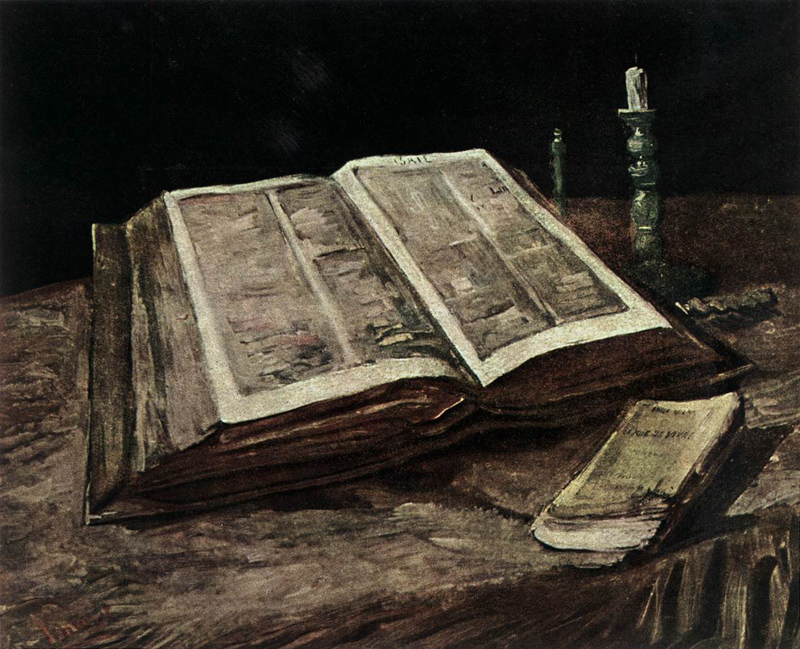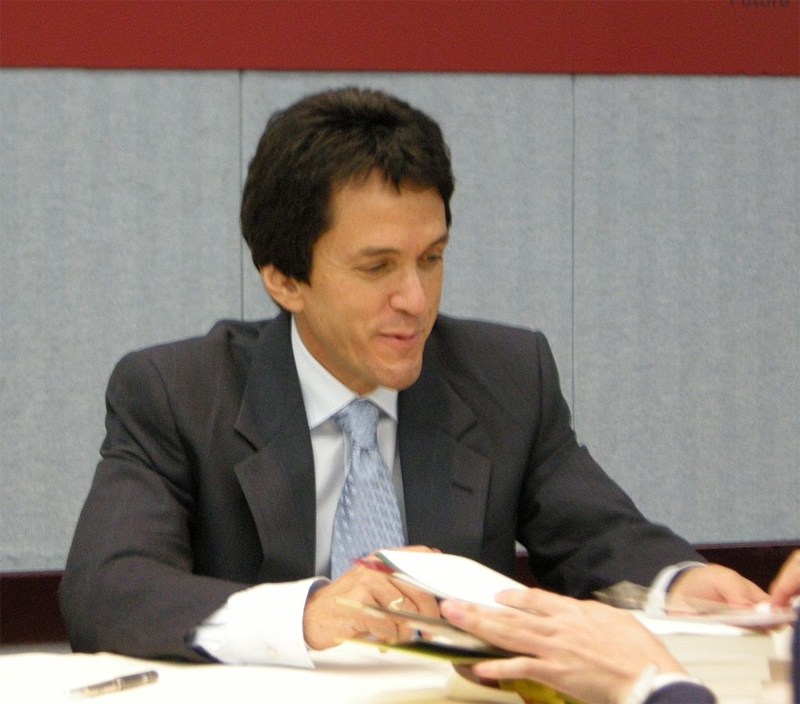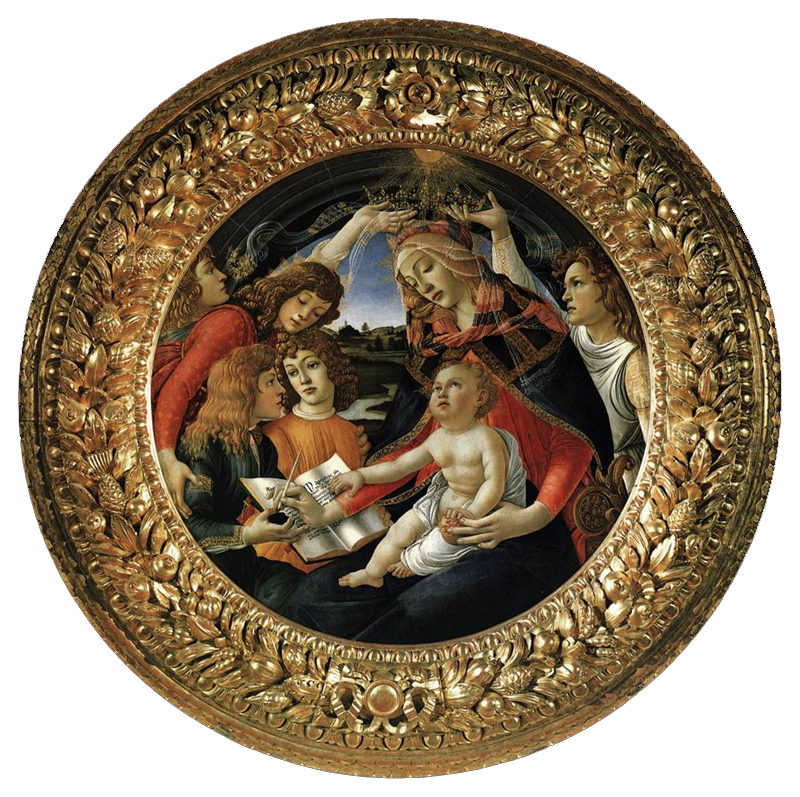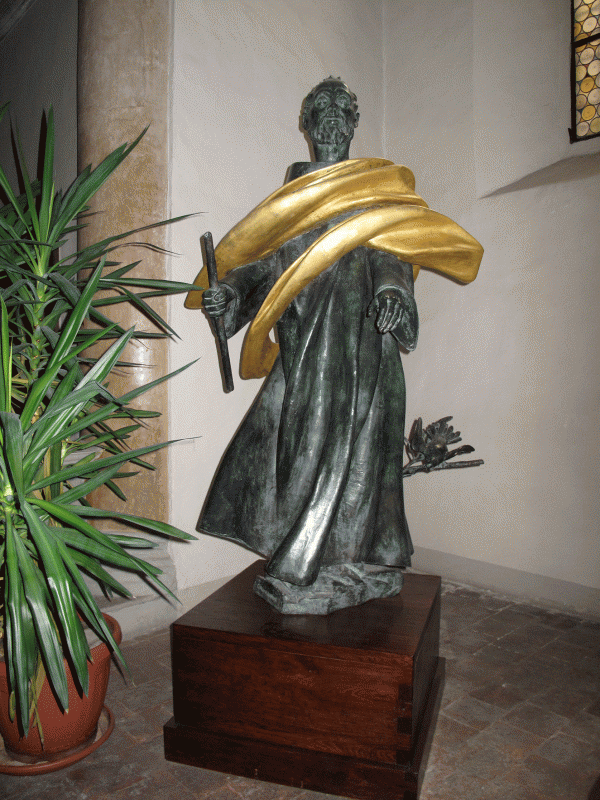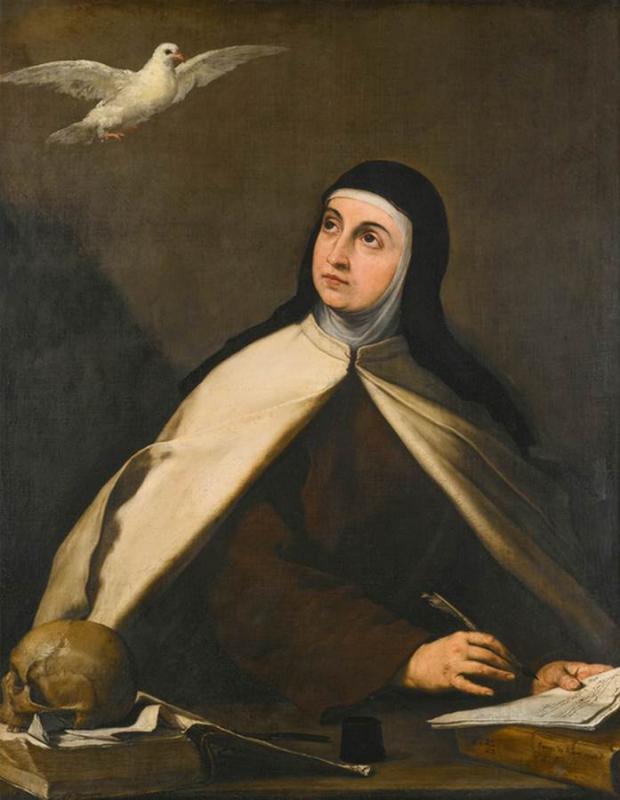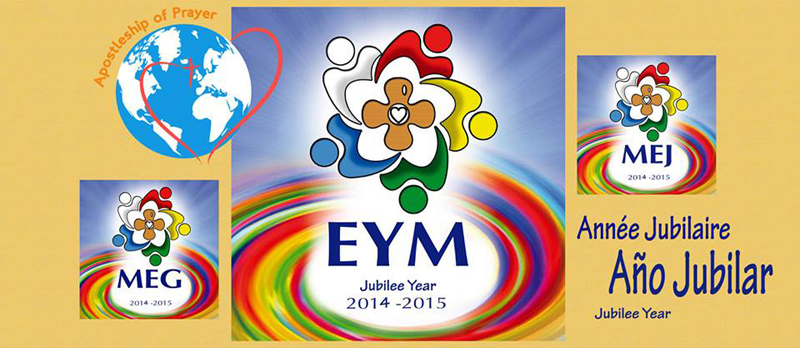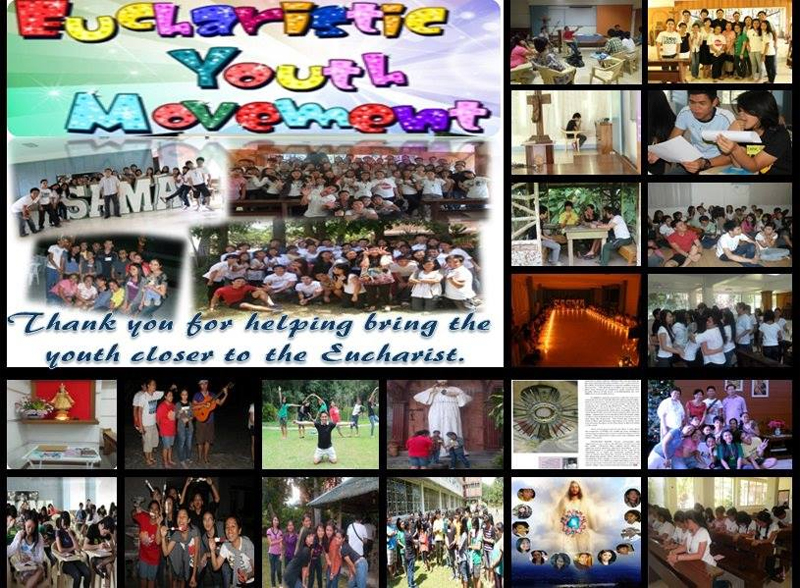Misyon Online - September-October 2015
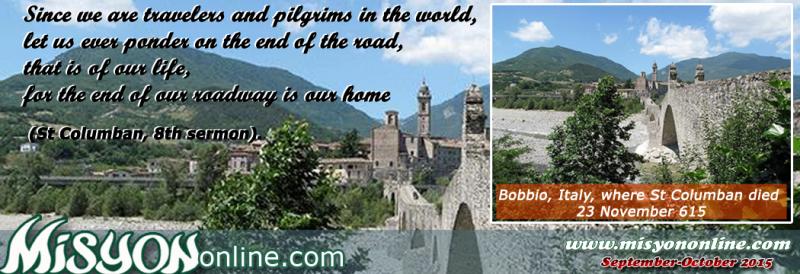


Rabbi Zalman Kastel, Sheikh Wesarn Charkawi and Fr Patrick McInerney after the Martin Place Siege, Sydney, December 2014
Columban Interreligious Dialogue Website
Recently the Missionary Society of St Columban launched a new website, www.columbanIRD.org, that is devoted to Interreligious Dialogue (IRD). The website describes interreligious dialogue in the words of Nigerian Cardinal Francis Arinze as ‘a meeting of people of differing religions, in an atmosphere of freedom and openness, in order to listen to the other, to try to understand that person’s religion, and hopefully to seek possibilities of collaboration. It is hoped that the other partner will reciprocate, because dialogue should be marked by a two-way and not a one-way movement. Reciprocity is in the nature of dialogue. There is give and take. Dialogue implies both receptivity and active communication.’

ST COLUMBAN, PILGRIM FOR CHRIST
This is the first of two articles on St Columban by a Columban priest who wishes to remain anonymous. The second article will appear in our November-December issue.
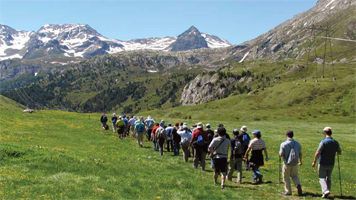 Some years ago when a group of us Columbans were preparing to celebrate Jubilee 2000, we wanted to do something out of the ordinary to mark the occasion. We focused on the idea of a pilgrimage following the footsteps of St Columban. Many of our generation in Britain and Ireland have had an experience of pilgrimage. It may have been our weekly pilgrimage as we walked along the road to the local church for Sunday Mass, doing the stations of the Cross, going to a holy well or journeying to places of devotion like Knock, Walsingham or Lourdes, Fatima, or Medjugorje. Some of us have done the old Celtic pilgrimages; be it climbing Croagh Patrick, or fasting and praying on Lough Derg, even perhaps walking to Santiago de Compostela.
Some years ago when a group of us Columbans were preparing to celebrate Jubilee 2000, we wanted to do something out of the ordinary to mark the occasion. We focused on the idea of a pilgrimage following the footsteps of St Columban. Many of our generation in Britain and Ireland have had an experience of pilgrimage. It may have been our weekly pilgrimage as we walked along the road to the local church for Sunday Mass, doing the stations of the Cross, going to a holy well or journeying to places of devotion like Knock, Walsingham or Lourdes, Fatima, or Medjugorje. Some of us have done the old Celtic pilgrimages; be it climbing Croagh Patrick, or fasting and praying on Lough Derg, even perhaps walking to Santiago de Compostela.
Our Christian life is wrapped up in pilgrimage as we move from birth to death and on to life eternal. As Columban missionaries following our patron’s footsteps across Europe, we rediscovered some important aspects of St Columban’s own understanding of pilgrimage.

MEANDERINGS OF A CATHOLIC MOTHER
By Mira Vanleeuwen
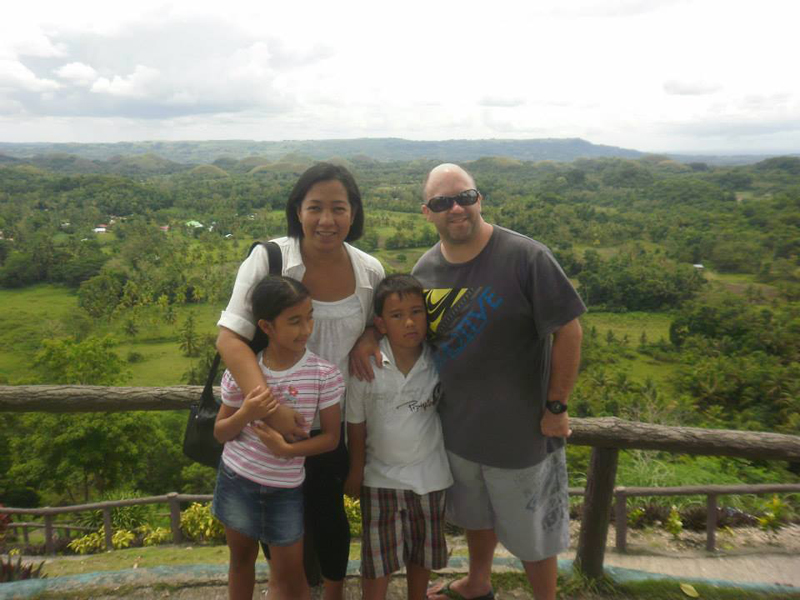
Mira and Family
I share the same birthday as Mama Mary, 8 September. It is something that I always hold dear in my heart, keeping me grounded in my faith no matter what. It’s been very challenging living here in Australia for about ten years now where most people hardly ever go to church. There is a certain concept here that as long as you're doing good you’re not a bad person. You will be all right and you don’t need God. People here are so open to almost anything, and of course they don’t mind things like same-sex marriage, something that greatly challenges my own principles and beliefs.

MYSTIFIED IN THIS ‘SELFIE’ TIME AND AGE
By Fr Richard Escoto OCD
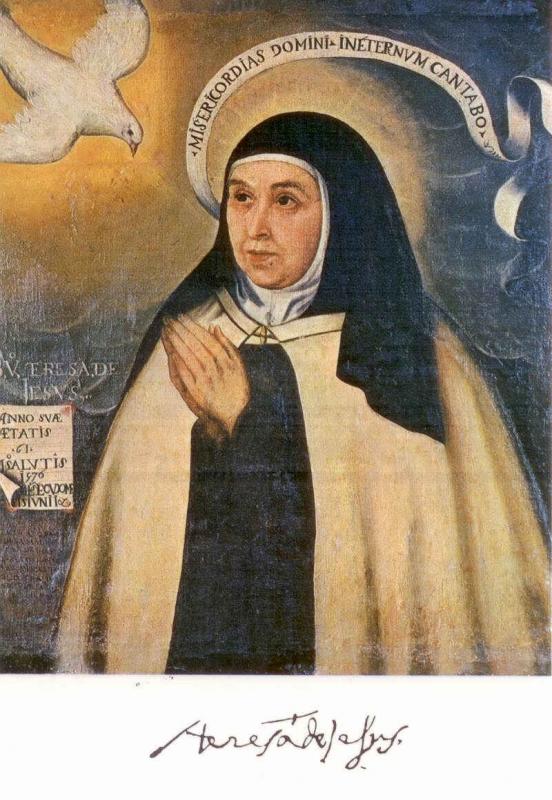
St Teresa of Ávila
‘This is the one portrait of Teresa that is probably the most true to her appearance. It is a copy of an original painting of her in 1576 at the age of 61.’
The author is currently the National Vocation Director of the Order of Discalced Carmelite Friars in the Philippines.
Vocations to the consecrated life are like the internet source. They continue to upload, unload and reload. And they are not running out of reach of a signal, with strong connections always from the source. They are ‘streaming live’.
Such a reality is awe-striking. It leads me to question more.

A JOURNEY AWAY FROM HOME
My Experience on First Mission Assignment
By Erl Dylan J. Tabaco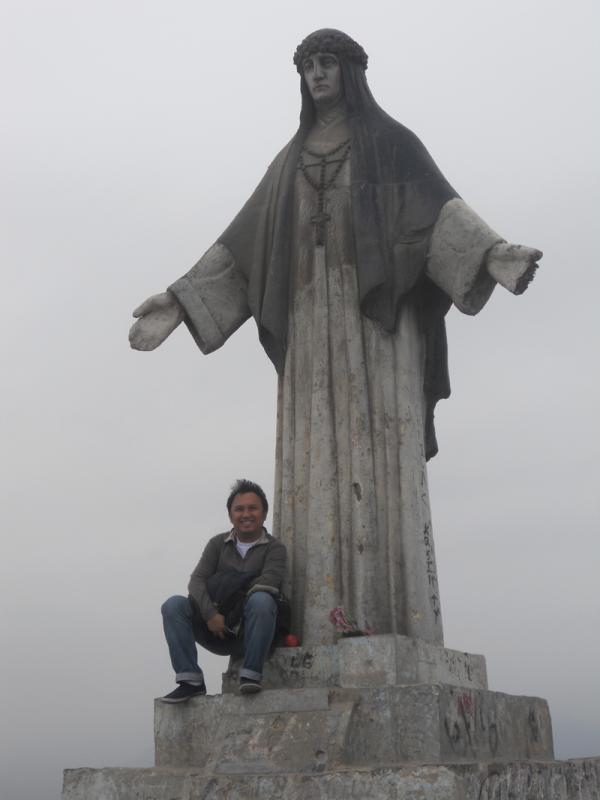
The author is a member of the Missionary Society of St Columban and is currently in Peru on his two-year First Missionary Assignment (FMA) as part of his preparation for the priesthood. He is from Cagayan de Oro City, Philippines. He went to Peru in 2014. This is the first part of his article. The second and final part will appear in the November-December issue.
The popular quotation, ‘A journey of a thousand miles begins with a single step’, penetrates into my consciousness when I think of my formation as a Columban since I entered the seminary in June 2007. This is exactly what my journey is all about – from a well-discerned decision to say ‘Yes’ to God’s invitation to the missionary priesthood to a daily commitment to the whole formation process. Those years of self-discovery, self-acceptance and self-giving in the formation program made me firm in my decision to continue and face another stage: my First Missionary Assignment (FMA).

WHERE AN ENCYCLICAL HITS THE NAIL ON THE HEAD
HONG KONG (SE): One of the criticisms directed against the recently released encyclical penned by Pope Francis entitled Laudato Si’: On care for our common home, is that he does not adequately take the ingenuity of the human being into account.
But the type of ingenuity displayed by logging and mining companies on the southern Philippine island of Mindanao that uses every trick in the book to get around national laws designed to protect the environment is well recognized in his landmark work.

OUR HIDEAWAY
Mother and Daughter
By Therese Diane N. Germinanda

Therese as a child with her mother, Lyn
For nine months, she bore the pain but still smiled
Her happiness was visible the day I came into her life
She is sweet, very thoughtful and caring too
Whenever I’m sad she knows what to do.
I am blessed to have her around
She picks me up always whenever I’m down
She is the light of our home and my life
I love my mother until the day I die

PEACE BY PEACE
Sincerely I learned about her, and ungrudgingly do I share—
|

YOUR TURN

Pope Francis with Eucharistic Youth Movement
7 August 2015
On Friday 10 August this year Pope Francis met with members of the Eucharistic Youth Movement from many parts of the world. He listened to questions from Magat Diop born in Italy of Senegalese parents, Gregorius Hanzel from Indonesia, Ana Carolina Santos Cruz from Brazil, Pin Ju from Taiwan, Louise Courant from France and Agustin Aschoff from Argentina. The full transcript of the audience can be found on the website of Zenit.org.

Pulong ng Editor

Rabbi Zalman Kastel, Sheikh Wesarn Charkawi and Fr Patrick McInerney after the Martin Place Siege, Sydney, December 2014
Columban Interreligious Dialogue Website
Recently the Missionary Society of St Columban launched a new website, www.columbanIRD.org, that is devoted to Interreligious Dialogue (IRD). The website describes interreligious dialogue in the words of Nigerian Cardinal Francis Arinze as ‘a meeting of people of differing religions, in an atmosphere of freedom and openness, in order to listen to the other, to try to understand that person’s religion, and hopefully to seek possibilities of collaboration. It is hoped that the other partner will reciprocate, because dialogue should be marked by a two-way and not a one-way movement. Reciprocity is in the nature of dialogue. There is give and take. Dialogue implies both receptivity and active communication.’
The website is a project of the Coordinating Committee of the Society's Interreligious Dialogue Network (Fr Pat Colgan, Hong Kong; Fr Sean Dwan, Ireland; Fr Liam O'Callaghan, Pakistan; Fr Paul Glynn, Philippines; Fr Patrick McInerney, Australia and New Zealand). It has been developed by Catholic Communications of the Archdiocese of Sydney.
At an interreligious and ecumenical gathering on 13 January this year in Colombo, Sri Lanka, a predominantly Buddhist country, Pope Francis said, ‘But, as experience has shown, for such dialogue and encounter to be effective, it must be grounded in a full and forthright presentation of our respective convictions. Certainly, such dialogue will accentuate how varied our beliefs, traditions and practices are. But if we are honest in presenting our convictions, we will be able to see more clearly what we hold in common. New avenues will be opened for mutual esteem, cooperation and indeed friendship.’
Columbans have been actively involved in interreligious dialogue for many years now, and not only in the countries where the committee members above are based. They have also been involved in ecumenical dialogue, which is that between Christians of different denominations. Quite often activities have both an interreligious and an ecumenical dimension.
Speaking in the context of the prolonged Civil War in Sri Lanka (1983 – 2009) the Pope said, ‘Such positive developments in interreligious and ecumenical relations take on a particular significance and urgency in Sri Lanka. For too many years the men and women of this country have been victims of civil strife and violence. What is needed now is healing and unity, not further conflict and division. Surely the fostering of healing and unity is a noble task which is incumbent upon all who have at heart the good of the nation, and indeed the whole human family. It is my hope that interreligious and ecumenical cooperation will demonstrate that men and women do not have to forsake their identity, whether ethnic or religious, in order to live in harmony with their brothers and sisters.’
Pope Benedict XVI visits the Blue Mosque, Istanbul, 2006
On a visit to Turkey in November 2006 Pope Benedict said, ‘Here I make my own the words of my immediate predecessor, Pope John Paul II of blessed memory, who said on the occasion of his visit in 1979: “I wonder if it is not urgent, precisely today when Christians and Muslims have entered a new period of history, to recognize and develop the spiritual bonds that unite us, in order to preserve and promote together, for the benefit of all men, ‘peace, liberty, social justice and moral values.’”’ (Address to the Catholic Community in Ankara, 28 November 1979).
The new website is a resource for individuals and groups involved in any way in interreligious dialogue, formal or informal, and for those who want to know what it is and what it isn’t.
Some years ago your editor found himself engaged in very real interreligious dialogue while sitting beside a Pakistani Muslim living in Dublin on a flight from Abu Dhabi to Dublin. This man had not only the Quran saved in his cell phone but also many parts of the Bible.
May this new resource, www.columbanIRD.org help many to engage in IRD as our recent Popes have urged us to do, not only by their words but by their example.
A Journey Away From Home
My Experience on First Mission Assignment
By Erl Dylan J. Tabaco
PART ONE

The author is a member of the Missionary Society of St Columban and is currently in Peru on his two-year First Missionary Assignment (FMA) as part of his preparation for the priesthood. He is from Cagayan de Oro City, Philippines. He went to Peru in 2014. This is the first part of his article. The second and final part will appear in the November-December issue.
The popular quotation, ‘A journey of a thousand miles begins with a single step’, penetrates into my consciousness when I think of my formation as a Columban since I entered the seminary in June 2007. This is exactly what my journey is all about – from a well-discerned decision to say ‘Yes’ to God’s invitation to the missionary priesthood to a daily commitment to the whole formation process. Those years of self-discovery, self-acceptance and self-giving in the formation program made me firm in my decision to continue and face another stage: my First Missionary Assignment (FMA).
The thought of being sent to another country and experiencing inter-cultural living there lingered in my mind and brought me mixed emotions: excitement, anxiety, joy and anticipation. I was at the same time anxious and lonely at having to leave my family and friends in the Philippines. The inspiring words of my rector, Fr Raymond Husband, and other Columban missionaries in the Philippines helped me to become more prepared for this journey. When I received my appointment to Peru from Fr Kevin O’Neill, our Superior General, I was very happy since this is where I wanted to do my FMA.
Time passed quickly and my preparations were over, from packing to a simple despedida (farewell) party. It was my first time to travel outside the country. A chance to explore the world made me excited all the more. After thirty-six hours of exciting travel our plane finally landed in the third largest country in South America, known for its famous landscapes and the birthplace of the Inca civilization and of St Rose of Lima: Peru. It was a memorable moment for me seeing different magnificent landscapes, meeting different people and reaching this stage of my formation.

After landing at Jorge Chávez International Airport, Lima, I felt anxious, not knowing what to do since everything was in Spanish. I was trying to calm myself while preparing what to say as I approached the immigration officer. With my improvised sign language and little Spanish, I was able to express myself. While waiting in the luggage section for Emmannuel Trocino from Pulupandan, Negros Occidental, my Filipino companion on FMA, my attention was caught by two signs in Spanish, ‘Bienvenido’ (welcome) and ‘Adelante’ (forward). At the time I didn’t know how significant those words would be on my missionary journey in Peru. Maybe they indicated important dispositions that a missionary should have.
Erl Dylan and Emmannuel were four years too late for this flashmob at Lima Airport!
Welcoming us were Fr Anthony Coney, Columban Regional Director in Peru, an Irishman, and Fr John Boles, FMA director, an Englishman, whose reassuring presence at the airport made me feel at home. On our way to the Columban central house I thought of my journey not just in terms of my recent flight but primarily in terms of my vocation to the priesthood. My heart was full of deep joy and gratitude for God’s indwelling presence through my experiences and through the persons I had met along the way.
I had to adjust to a thirteen-hour time difference – behind the Philippines. The winter season was also something new to me. Coming from a tropical country with an average daytime temperature of 31C, often higher, the sudden shift to 15C or so was a big adjustment. But I had brought some winter clothes with me.
As I immersed myself in a new environment, culture, language and lifestyle I was reminded of my years in my local parish in Cagayan de Oro as a youth volunteer working with some Columban priests. Those significant years of parish involvement taught me about kindness and generosity. Through that first-hand experience with those missionaries, their simple ways and dedication to the local Church in the Philippines, I have learned to value my own calling and to relish the missionary spirit within me. It is only in finding my heart’s desire and allowing that desire to grow by touching the lives of other people that I can truly live my life’s purpose. Revisiting my experience in Cagayan de Oro and applying the values I had learned there gave me a fresh mindset and spirit-filled first night in Peru as I looked forward to the coming days.

Erl and Emman with Columban Missionary Ana Flores
Prior to starting in language school we had an orientation program about Peru in general and the history of Columban mission in the country. It is an indispensable tool for every missionary to learn about and appreciate the ‘new’ country and how the people there live, to learn something of their customs and traditions before even going there. Immersing yourself in another culture is like entering into another’s garden where you will encounter weeds among the wheat. What appears as weed to us may appear as wheat to the local people. I realized then that having cultural sensitivity and awareness of individual differences can somehow mitigate one’s biases and prejudices. We met the rest of our FMA team who were to accompany us throughout our stay in Peru. It gave much assurance to Emmannuel and me that it would be a great experience for both of us.
Pollo a la Brasa [Wikipedia]

Caption: Ceviche [Wikipedia]
We tried two famous Peruvian dishes which Peruvians had told us about, ‘Pollo a la Brasa’ (grilled chicken with French fries) and ‘Ceviche’ (raw fish mixed with lemon juice). We visited colonial churches and mansions, historical and religious statues of two Peruvian saints, St Rose of Lima and St Martin de Porres, and enormous museums which depicted the strong Spanish influence on Peruvian culture and art. This helped me appreciate the uniqueness and grandeur of what Peru can offer to the world.
Cathedral of St John the Evangelist on the Plaza Mayor, Lima [Wikipedia]
Strolling around the Plaza de Armas, now officially known as the Plaza Mayor in the heart of colonial Lima allowed me to appreciate the history of my own country and how the Filipino people struggled under the Spanish regime. Centuries have passed, but memories remain in all of these monuments. What I enjoyed throughout our whole visit was meeting people, though most of the time I struggled with the language. Luckily we had Ana Flores, a Columban Lay Missionary from Peru who is based in Cagayan de Oro, who never tired of explaining everything to us in our own language. Ana has become proficient in both Cebuano and English since coming to the Philippines.
Plaza Mayor (Plaza de Armas), Lima
Having a two-week orientation program and wandering around the beautiful places of Lima helped me relieve my home-sickness. It was a great experience and a good opportunity to regain energy before the mind-boggling language classes started.
‘You cannot give what you do not have’ is a saying that always inspires me in everything that I want to accomplish. To have a fruitful missionary experience is still a work in progress and the outcome of this experience depends on how I give myself totally to this undertaking. [To be continued in the next issue].
|
Two Dominican Saints from Lima
|
Meanderings of a Catholic Mother
By Mira Vanleeuwen

Mira and Family
I share the same birthday as Mama Mary, 8 September. It is something that I always hold dear in my heart, keeping me grounded in my faith no matter what. It’s been very challenging living here in Australia for about ten years now where most people hardly ever go to church. There is a certain concept here that as long as you're doing good you’re not a bad person. You will be all right and you don’t need God. People here are so open to almost anything, and of course they don’t mind things like same-sex marriage, something that greatly challenges my own principles and beliefs.
Coming from a much poorer country made me reflect that as a Filipino my faith keeps me going. Things may be seen differently by people who live in an affluent world where much is easy and people don’t feel the need to depend on Someone much, much greater. Topics like faith and God would seem mundane if not weird to them. The irony that I can often see is that there is an atmosphere of people searching constantly for something missing in their lives.
My situation here in Australia is like that of a grocery shopper. As soon as I enter the supermarket I'm bombarded with so many marketing ads to entice me to buy what they offer. If I'm not smart I could very well buy things that I don't need. But if I stick to my shopping list more likely I’ll be on track with my budget.

Father Seán, Willy and his daughter Maeve, Melbourne 2009
There are so many distractions here. If I don’t keep myself in tune with God through prayer, through attending Mass and reading Bible passages I can easily slide away. Maintaining my relationships and friendships with my Catholic friends sustains me and inspires me to go on. I remember with fondness the time when Fr Seán Coyle visited my family six years ago. I felt special, honored and thankful to God for the grace of getting to know Columbans like him and the late Fr Niall O’Brien. In fact I named my son after Father Niall and named my daughter after his favorite author, Maeve Binchy.
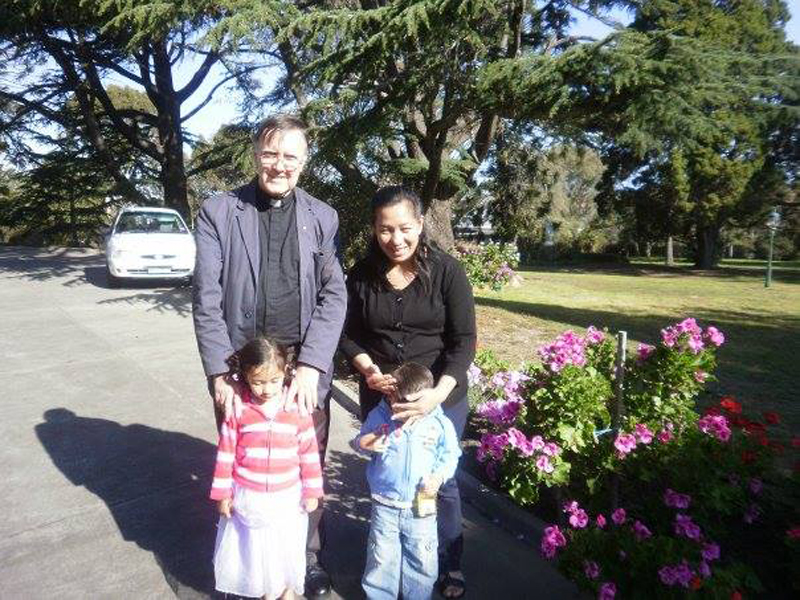
Mira and her children with Father Seán, Melbourne 2009
As a mother, it is important for me to ensure that my children grow in their faith and that they truly understand Catholic doctrine and practices. I believe it will keep them grounded as we live in this very modern and free-thinking world. I try as much as I can to emulate Mama Mary's qualities: her obedience to the will of the Father and her nurturing love and motherly care for Jesus. It is as important as living the legacy my parents left me by bringing me up as a Catholic.
Just recently God's affirmation to my prayers is slowly coming into view by seeing Willy, my husband, a Dutch descent who grew up in Australia, little by little giving service at Sunday Mass as an altar-server. And Niall, seeing his Dad being so involved in the Mass, is encouraged by him to help at the altar too. He used to refuse to go with the other children to the children's liturgy of the Word but now he joins them with no fuss. And now without any prodding from me, Niall or Maeve says Grace before meals. Yes, these are some simple yet profound joys of being a Catholic. I will never trade them for anything in this world.
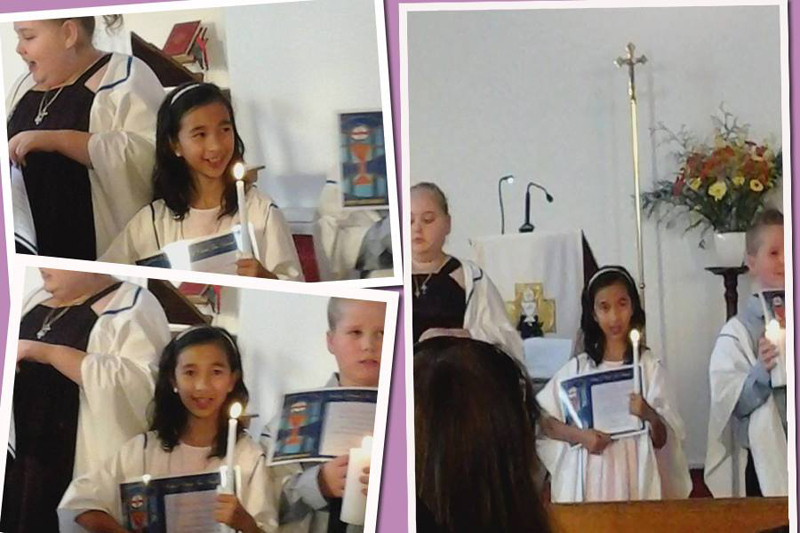
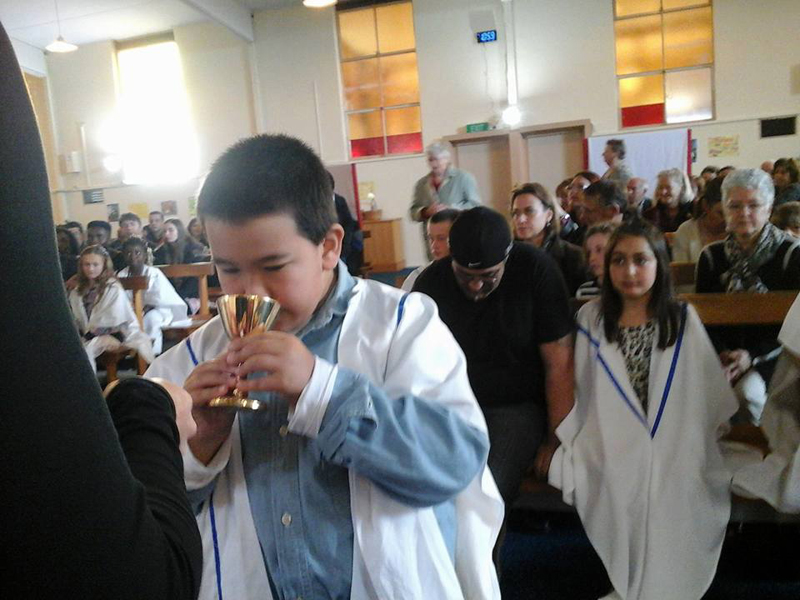
Niall and Maeve at their First Holy Communion
Mystified in this ‘Selfie’ Time and Age
By Fr Richard Escoto OCD

St Teresa of Ávila
‘This is the one portrait of Teresa that is probably the most true to her appearance. It is a copy of an original painting of her in 1576 at the age of 61.’
The author is currently the National Vocation Director of the Order of Discalced Carmelite Friars in the Philippines.
Vocations to the consecrated life are like the internet source. They continue to upload, unload and reload. And they are not running out of reach of a signal, with strong connections always from the source. They are ‘streaming live’.
Such a reality is awe-striking. It leads me to question more.
With our young generation so hooked up to the materialistic and pabebe [behaving like a young child to draw attention to oneself] culture and with the world we live in that is moving more and more into secular ideologies and living less and less by moral and value principles, fear lurks as regard the vocation ministry today. ‘Will there be souls today brave enough to live for God? Will there still be souls who can make God their first priority in life?’ Not only fears lurk; but even doubts of having good vocation today prowl.
But I am wrong. Vocations are alive in this time and age.
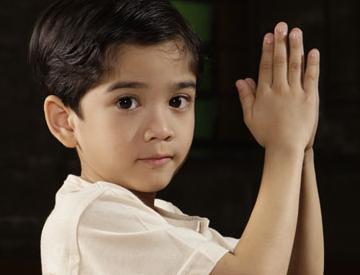 ‘Santino’, played by Zaijan Jaranilla |
 The Little Man in Brown |
And lastly, there is a famous doctor. This is a story that can surely melt even callous hearts. On 15 August this year a doctor from a well honored hospital professed her solemn vows as a nun. What is mysterious is that she embraced the cloistered consecrated life! Her journey was from the active life of a medical doctor to that of a cloistered, hidden and silent nun. And this nun had not been just an ordinary doctor, but the first Filipina colorectal surgeon in the country. Despite what she had achieved in life, the ‘call within’ was what mattered most. As one friend who had attended the moving solemn vows ceremony testified, ‘She had woven for herself a successful medical career and two fellowships abroad in addition to her intensive training. She had both brains and money, could have established a career anywhere in the global community, with the world at her feet. But yesterday at her solemn vows - a more beautiful story has just begun. She prostrated herself before the altar of God and vowed to spend her whole life as a Carmelite.’
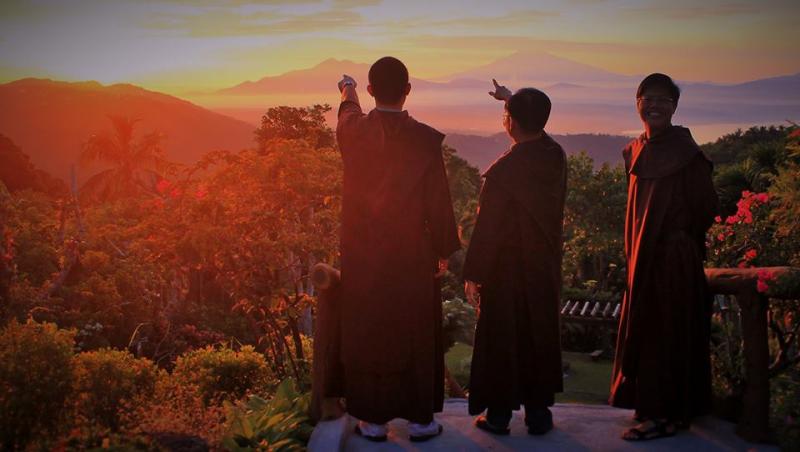
Rightmost is Father Richard with student friars
I cannot put into words what I have seen. All I can do is to be still and silent with the Mystery of vocation. Even in this time of pabebe, ‘selfies’, groupies and touch-screens, Vocations to the priesthood and religious life are streaming live! Because in reality and in humility, Vocations are God’s work. We are just instruments. Let us just prepare the seeds and nurture them. The true disposition of St Paul, the Apostle is at work here: ‘ I planted, Apollos watered, but God caused the growth’ (1 Cor 3:6).
|
St Columban, Pilgrim for Christ
This is the first of two articles on St Columban by a Columban priest who wishes to remain anonymous. The second article will appear in our November-December issue.
 Some years ago when a group of us Columbans were preparing to celebrate Jubilee 2000, we wanted to do something out of the ordinary to mark the occasion. We focused on the idea of a pilgrimage following the footsteps of St Columban. Many of our generation in Britain and Ireland have had an experience of pilgrimage. It may have been our weekly pilgrimage as we walked along the road to the local church for Sunday Mass, doing the stations of the Cross, going to a holy well or journeying to places of devotion like Knock, Walsingham or Lourdes, Fatima, or Medjugorje. Some of us have done the old Celtic pilgrimages; be it climbing Croagh Patrick, or fasting and praying on Lough Derg, even perhaps walking to Santiago de Compostela.
Some years ago when a group of us Columbans were preparing to celebrate Jubilee 2000, we wanted to do something out of the ordinary to mark the occasion. We focused on the idea of a pilgrimage following the footsteps of St Columban. Many of our generation in Britain and Ireland have had an experience of pilgrimage. It may have been our weekly pilgrimage as we walked along the road to the local church for Sunday Mass, doing the stations of the Cross, going to a holy well or journeying to places of devotion like Knock, Walsingham or Lourdes, Fatima, or Medjugorje. Some of us have done the old Celtic pilgrimages; be it climbing Croagh Patrick, or fasting and praying on Lough Derg, even perhaps walking to Santiago de Compostela.
Our Christian life is wrapped up in pilgrimage as we move from birth to death and on to life eternal. As Columban missionaries following our patron’s footsteps across Europe, we rediscovered some important aspects of St Columban’s own understanding of pilgrimage.
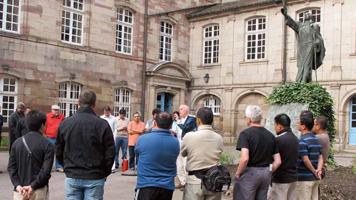 St Columban, or Columbanus, was undoubtedly ‘a pilgrim for Christ’. His initial encounter with the person of Christ was an interior journey to the depths of his own being. To accomplish this, St Columban took his inspiration from the Desert Fathers, especially St Anthony the Abbot. He sought out places of solitude. There, leaving what was familiar and comfortable, he faced his own spirit, his demons, and embarked on a life of conversion that would lead him to the authentic truth, to the person of Christ.
St Columban, or Columbanus, was undoubtedly ‘a pilgrim for Christ’. His initial encounter with the person of Christ was an interior journey to the depths of his own being. To accomplish this, St Columban took his inspiration from the Desert Fathers, especially St Anthony the Abbot. He sought out places of solitude. There, leaving what was familiar and comfortable, he faced his own spirit, his demons, and embarked on a life of conversion that would lead him to the authentic truth, to the person of Christ.
The aspect of pilgrimage as a penitential journey was strongly present in monasteries of the medieval period. The Celtic monks embraced it as the consequence of the sin of the world. St Columban took upon himself the sins of others and gave his life to saving people from the wrath of sin, and leading them to Christ. His life was focused on Christ and his pilgrimage was a journey to eternal life. He saw the penitential way as a means of reaching that destination.
St Columban’s vocation to the contemplative life was accompanied by a great desire to share the riches of the Gospel with those who had not yet converted to Christ and his Kingdom. Living out this commitment led him to cross oceans, navigate rivers, hike over mountains and negotiate difficult terrain to meet peoples and kings in order to celebrate the presence of the risen Christ in their midst. He did not compromise on the Gospel message nor did he try to accommodate the teachings of Jesus to the likes and dislikes of his listeners. This often brought him into conflict with local kings and bishops and eventually led to his expulsion from the Burgundy region then known as Austrasia.
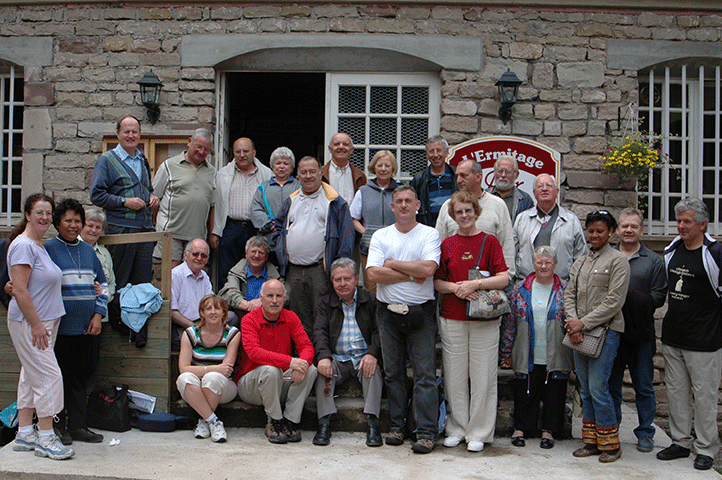
St Columban had respect for the terrain on which he journeyed. The pathways were sacred ground. He was walking in the footsteps of Christ, whose presence was there long before him. He came to encounter Christ in the solitude of the forest, the sound of lapping water, the music of the wind, and the roar of the bear and the song of the birds. Tradition has it that it was a bear that brought him wood, and was, in turn, rewarded with wheaten cakes. He sang the psalms to the humming of the birds and gave comfort to the animals in wintertime. The power of the Creator was carved on the rocks and crevices of the caves where he found refuge to pray and be alone. God’s presence in creation was always a living reality for him.
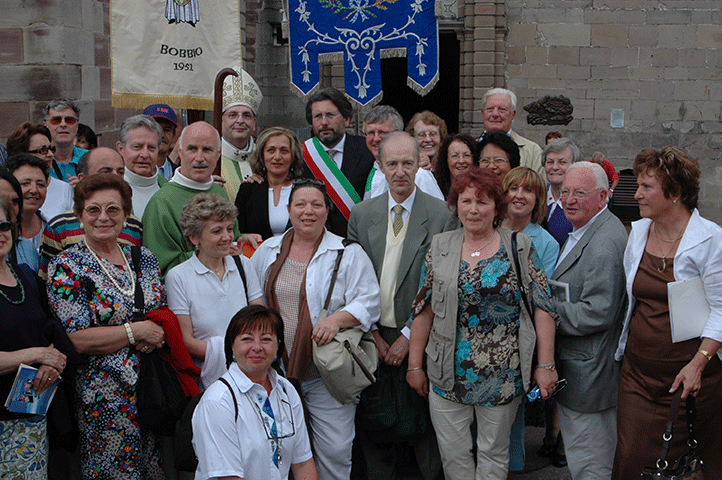
An essential aspect of pilgrimage for St Columban was community. Though he spent many hours in solitude, he lived in community. He founded monastic communities and invited people to come, stay and live under the Rule. The Irish term for monastery, mainistir, is cognate to muintir meaning household, family or community. For St Columban, to be disciple of Christ was to live in community. Eucharist was at the heart of that community. This did not mean that the Eucharist was celebrated daily in Columban monasteries, but rather that the center and source of communion for Christian people, and therefore for every monastic community, is the person of Christ present in the Eucharistic Bread and viaticum (food for the journey). Not only is the wanderer nourished by wheat and rice, but with the Bread of Life, the Bread of the Word, the Eucharistic Bread. St Columban could spend many days fasting from bodily food, but never went without celebrating his communion with the Lord and with his brothers.
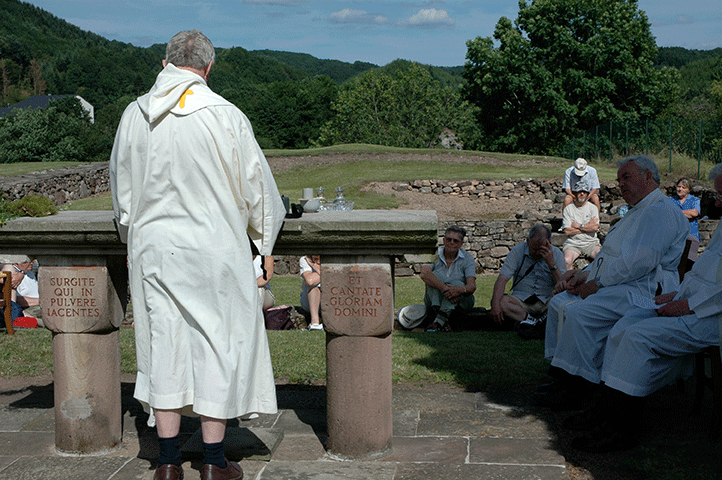
Following the footsteps of St Columban in the 21st century took us through towns and cities, shopping malls, farmers’ markets, social housing schemes, built-up wealthy residential areas, dangerous highways, roads congested with traffic, open spaces, deserted hills and ancient pathways. Amid the crowd and noise of our surroundings we, like St Columban, experienced moments of the sacred that gave us renewed energy to go back to our habitual place of work and mission, to continue on life’s journey and pilgrimage.
This article appeared in the January-February 2015 issue of Far East, the magazine of the Columbans in Ireland and Britain.
Where an encyclical hits the nail on the head
One of the criticisms directed against the recently released encyclical penned by Pope Francis entitled Laudato Si’: On care for our common home, is that he does not adequately take the ingenuity of the human being into account.
But the type of ingenuity displayed by logging and mining companies on the southern Philippine island of Mindanao that uses every trick in the book to get around national laws designed to protect the environment is well recognized in his landmark work.
Long-time missionary to the Philippines, Columban Fr Sean Martin, points out that what is known as the Zamboanga Peninsula in Mindanao was once lush, dense tropical forest - that is until Misamis Lumber Corporation began cutting the huge trees on the slopes of the sacred watershed in the Sugarloaf Range in 1977. He says that a new road increased the ability of the company to move greater and greater amounts of the timber to the storage pond about eight kilometers away and, by 1982, the payload had increased from around ten to 30 truckloads a day.
But as the local people watched the top soil being eroded, their rivers silting up and water supply becoming polluted and diminishing they acted to stop the logging. A five-month day-and-night picket was organized and received support from people all over the Diocese of Pagadian as they began to understand what the consequences of the logging were. Thanks to the support of the local police, the picket remained peaceful and in 1988 Misamis Lumber Corporation lost its logging license and Sunville Timber Products, Inc took over, but reaped the fruit of the fragile landscape at a much lower rate.
The people saw the opportunity and the need to replant the mountain and their insight was supported by a meeting of the Multilateral Aid Initiative, made up of representatives of donor countries and aid groups that support the Philippines, held in Manila on 13 and 14 February 1990, which strongly recommended concern for the environment and sustainable livelihood projects. The Multilateral Aid Initiative called for and received the cooperation of several Philippine government departments in having legislation passed to restore the forest land and to conserve the biological diversity that incorporated both biological and social concerns in its planning.
With a grant from the World Bank of US$1,000,000 (Php41,000,000 at the time), the local Subaanen indigenous people began the work of replanting the bare hills with fruit and forest trees, and did the back-breaking work of contouring the slopes to stop the erosion. They rehabilitated over 1,000 hectares of stripped land. The people succeeded in creating a sustainable and profitable network of rice lands, orchards and vegetable producing plots, as well as fish ponds and irrigation channels.
But in 1996 mining companies set their sights on the land. First, Rio Tinto applied for 600,000 hectares. The then Bishop of Pagadian, Zacharias C. Jimenez, said, ‘It will tear the heart out of the land’.

When pickets and appeals to the authorities failed, Jimmy Tindao and two Columbans, Sister Margaret Murphy and Fr Frank Nally, traveled to London to present the case at the annual general meeting of Rio Tinto. ‘Maybe you shareholders will get some money, but we the people who live on the land will perish’, they read from a letter penned by the bishop to the meeting.
Rio Tinto heard their plea and backed off, but the Philippine government Department of the Environment and Natural Resources and the Mines and Geosciences Bureau did not, nor did companies such as 168 Ferrum Pacific Mining Corporation and the Chinese Huaming Mineral Resources Corporation. They conspired to flaunt the law, using their ingenuity to falsify documents and skirt around the national laws that govern the acquisition of land in a watershed within an indigenous ancestral heritage area.
Father Martin says that today there is a strong awareness among the people that destroying nature brings calamity, but mining companies are using self-serving politicians to disinherit the people. He says that the high death toll during Typhoon Thelma/Uring in 1991 and then Washi/Sendong and Bopha/Pablo in 2011 and 2012, as well as Haiyan/Yolanda in 2013, is directly related to the deforestation caused by mining and logging. He pointed out, ‘People power can be strong in the midst of such devastation, but people in power can thoughtlessly destroy the invisible capital of nature’. He went on to say, ‘The lesson that when nature gets angry, even the rich and powerful die has still not been learned’.
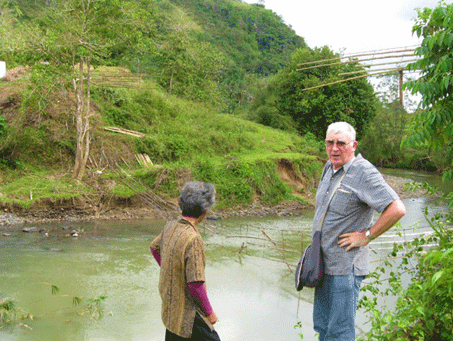
As he looks at the devastation, Father Martin agrees wholeheartedly that Pope Francis’ words in his encyclical hit the nail on the head when he wrote, ‘The earth, our home, is beginning to look more and more like an immense pile of filth’.
Certainly in the case of the Zamboanga Peninsula, Father Martin agrees with the Pope that corporate greed and political paralysis are running the show. He says that the Subaanen people know that everything is connected, as the Pope notes. They know that you cannot separate ecology from economics, ethics from politics. ‘True ecological approach always becomes a social approach; it must integrate questions of justice in debates on the environment, so as to hear both the cry of the earth and the cry of the poor’, Pope Francis says in his encyclical.
The Pope told a gathering in Rome organized by the Pontifical Council for Justice and Peace, held on July 17 on the negative effects of mining on local people, that he believes that the operation of the industry needs to undergo a paradigm shift. ‘A cry for lost land; a cry for the extraction of wealth from land that paradoxically does not produce wealth for the local populations who remain poor; a cry of pain in reaction to violence, threats and corruption; a cry of indignation and for help for the violations of human rights, blatantly or discreetly trampled with regard to the health of populations, working conditions, and at times the slavery and human trafficking that feeds the tragic phenomenon of prostitution; a cry of sadness and impotence for the contamination of the water, the air and the land; a cry of incomprehension for the absence for inclusive processes or support from the civil, local and national authorities, which have the fundamental duty to promote the common good’, the Pope told the gathering.
Father Martin hopes that the plea from the Pope will awaken us all to join with the indigenous people who have given the widow’s mite to protect the life-giving qualities of nature, but he fears it is being tossed out and trampled underfoot.
But the Pope, in taking the discussion on the environment away from being a mainly political, scientific and economic one, to one about the nature of a holy and precious gift from God, expresses the hope that change is possible, as human beings can rise above themselves to choose what is good.
And, as Fr Andrew Hamilton SJ notes in Eureka Street on 21 June, science can document and demonstrate what will happen if things continue the way they are going. ‘Religions are in the business of conversion and their beliefs and symbols can underpin the change of heart necessary for concerted action’.
Even the human genius that so cleverly skirts the law could be transformed into one that supports the common wealth and common good of the planet.
This article first appeared in Sunday Examiner, the English-language weekly newspaper of the Diocese of Hong Kong.
Mina hulga sa kinabuhi / Mining a threat to life
Our Hideaway
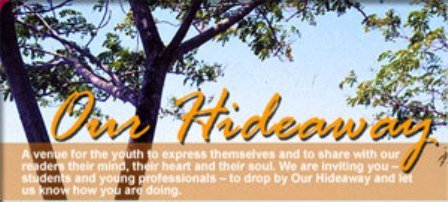
Mother and Daughter
By Therese Diane N. Germinanda

Therese as a child with her mother, Lyn
For nine months, she bore the pain but still smiled
Her happiness was visible the day I came into her life
She is sweet, very thoughtful and caring too
Whenever I’m sad she knows what to do.
I am blessed to have her around
She picks me up always whenever I’m down
She is the light of our home and my life
I love my mother until the day I die
She taught me things I never learned in school
Patience’, she said, Patience is a virtue
She taught me how to behave and be polite
She also taught me how to read and write
We may have had fights and misunderstandings
But I know she is the only one who can understand my feelings
At the end of the day she’s the only one I can run to
The arms that will comfort me and words spoken, ‘I love you’.
I miss her now as I write this down
But a million miles away will never make me frown
For I hold her close and dear to my heart
It’s me and her against the world right from the very start
And, through this, I remember our own virgin mother Mary;
Who has always been gentle and silent yet contented and happy
To cradle in her arms her only Son, Jesus Christ;
And watch him grow all the days of her life.
Mary, who has never spoken a word of argument or complaint
Took the challenge and proudly claimed
To be the mother of our Messiah
Despite the impeccable dangers.
And, because of this, I clearly saw
That being a mother was never a joke
The sleepless nights and the endless days
The struggles and the pain.
And, just like Mary, my mother always found the strength
Chin held up high with all the love in her heart that has no end
Mary, like all mothers in the world, loves with a love that is unconditional
And I, too, love her and my mother with a love that is eternal.
Peace By Peace

Sincerely I learned about her, and ungrudgingly do I share— ~ Wisdom 7:13-14 ~ |
But there's a story behind everything. How a picture got on a wall. How a scar got on your face. Sometimes the stories are simple, and sometimes they are hard and heart-breaking. But behind all your stories is always your mother's story, because hers is where yours begin. ~ Mitch Albom, For One More Day ~ |
Mary is the morning star preceding the Light of the World, Christ. The only difference is that all her light is derived from the Son she heralds. By God’s eternal decree Mary has been associated with highest mysteries of the Christian religion, being the very instrument of the Incarnation of the Eternal Son of God, and, therefore, of our redemption. We have devotion to her both because of our admiration of her, and because of her interest in our eternal welfare. When we honor Mary, of course, we are but honoring Christ in her. Without Him, she would be nothing, and she would be the first to admit it. And the honor we show her cannot displease Christ. He was the best Son who ever lived, and would rather be displeased were His Mother ignored or slighted. Remember the bootblack’s answer to the parson. Whilst having his boots polished, the parson saw a medal of the Virgin Mary hanging from the boy’s neck on a string. ‘Sonny,’ he said, ‘why do you wear that?’ ‘She is the Mother of Christ,’ said the boy. ‘But,’ objected the parson, ‘she’s no different from your own mother’. ‘No,’ replied the boy, ‘but there’s a hell of a difference between the sons’. We owe love and devotion to the Mother of Christ. ~ Fathers Rumble and Carty, Radio Replies – Volume III ~ |
|
Magnificat anima mea Dominum: |
|
Be submissive to good, unbending to evil, gentle in generosity, untiring in love, just in all things. ~ St Columban, Letter to a young disciple ~ |
|
Peace, peace, the Lord said, my Sisters; and He urged His apostles so many times. Well, believe me, if we don’t obtain and have peace in our own house we’ll not find it outside. Let this war be ended. Through the blood He shed for us I ask those who have not begun to enter within themselves to do so; and those who have begun, not to let the war make them turn back. ~ Spiritual Counsels of Saint Teresa of Jesus ~ |
|
Paperwork, cleaning the house, dealing with the innumerable visitors who come all through the day, answering the phone, keeping patience and acting intelligently, which is to find some meaning in all that happens – these things, too, are the works of peace. Source: The Catholic Worker, December 1965. Thanks to www.plough.com for this quotation through its Daily Dig. |
Your Turn

Pope Francis with Eucharistic Youth Movement
7 August 2015
On Friday 10 August this year Pope Francis met with members of the Eucharistic Youth Movement from many parts of the world. He listened to questions from Magat Diop born in Italy of Senegalese parents, Gregorius Hanzel from Indonesia, Ana Carolina Santos Cruz from Brazil, Pin Ju from Taiwan, Louise Courant from France and Agustin Aschoff from Argentina. The full transcript of the audience can be found on the website of Zenit.org.
Agustin asked this question: Pope Francis, what would you say to young people so that they discover the profundity of the Eucharist?
Here is the Pope’s response.
It always helps to think of the Last Supper, and that word that Jesus said when he gave the bread and wine, his Body and his Blood: ‘Do this in memory of me’. The memory of Jesus present there; the memory of Jesus that, in every Mass, is there - and he saves us there! - the memory of that gesture of Jesus, who afterwards went to the Garden of Olives to begin his Passion. The memory of such great love he who gave his life for me! Each one of us can say this.
The grace of memory, of which I spoke when I talked about grandparents, the grace of memory: the memory of what Jesus did. It’s not just a ritual, it’s not a ceremony. There are very beautiful ceremonies, military ceremonies, cultural . . . no, no. It’s something else: it’s to go there, to Calvary, where Jesus gave his life for me. Each one should say this. And with this memory, seeing Jesus, receiving the Body and Blood of Jesus, one reflects deeply on the mystery of the Eucharist.
‘Oh Father, when I go to Mass I’m bored . . .’ Because it isn’t a ritual. Remember this, if you want to deepen your reflection on the mystery of the Eucharist. This is a good verb, because Paul says it to one of his favorite disciples – I don’t remember if it was to Titus or Timothy, but to one of the two, who were two Bishops whom he had made Bishops.
Remember Jesus Christ (cf. 2 Timothy 2:8). Remember Jesus Christ, when I am at Mass there, he who is giving his life for me. And thus one deepens one’s reflection on the Mystery. And then, when you don’t go to Mass, but go to pray before the Tabernacle, remember that He is there, and that He gave his life for you. The memory. It was the command that Jesus gave his own: ‘Do this in memory of me’. That is, every time you do this celebration, remember me; every time you go to pray before the Tabernacle, remember this. And don’t forget what Saint Paul said to his disciple, also a Bishop: Remember Jesus Christ!
|
|



